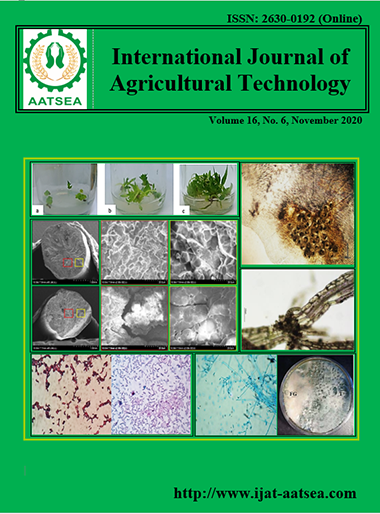Effect of prewashing silages of Panicum virgatum L. on carbohydrate composition, enzyme hydrolysis and yeast fermentation
Main Article Content
Abstract
Ensilages of Panicum virgatum L. prewashed with hot water and limewater solution were evaluated for carbohydrates composition, efficiency of enzymes hydrolysis and products of yeast fermentation. Samples of three switchgrass varieties prewashed with and without limewater solution, rinsed with hot water, analysed for reducing sugar, glucans, xylan, arabinan and acid soluble lignin, subjected to 1:4 ratio of Cellulase Cellobiase enzyme hydrolysis and fermentation by common yeast. Composition analysis revealed Bomaster variety contains reducing sugars and glucan significantly higher than varieties of Performer and Colony but it was equally comparable in xylan, arabinan and lignin contents. Enzyme hydrolysis converted xylan into solubles in silages prewashed with limewater solution with 62.21% efficiency compared to 48.47% in hot water washed silages. Fermentate of switchgrass produced low amount of ethanol which was attributed to lack of sufficient glucan, while the high yiled of acetate was attributed to high contents of xylan and arabinan. Prewashing silages with limewater washout and neutrilize silages, enhances enzyme hydrolysis pretreatment and impact yeast fermentation. Recommendation is to select yeast with ethanol fermentation from both glucan and xylan and arabinan, improvement in the conditions of fermentation of pentose sugars in the absence of sufficient glucan. Information generated in this study is useful in the process of prewashing as complement of ensiling as preservation of feedstock intended for ethanol production.
Article Details

This work is licensed under a Creative Commons Attribution-NonCommercial-NoDerivatives 4.0 International License.
References
Burns, J. C., Godshalk, E. B. and Timothy, D. H. (2008a). Registration of colony switchgrass. Crop Science, 2:29-30.
Burns, J. C., Godshalk, E. and Timothy, D. H. (2008b). Registration of performer switchgrass. Crop Science, 2:31-32.
Chen, Y., Sharma-shivappa, R., Keswani, D. and Chen, C. (2007a). Potential of agricultural residue and hay for bioethanol production. Applied Biochemistry and Biotechnology, 142:276-290.
Chen, Y. Sharma-shivappa R. R. and Chen, C. (2007b). Ensiling agriculture residue for bioethanol production. Applied Biochemistry and Biotechnology, 143:80-92.
Cunha, J. T., Soares, P. O., Romaní, A., Thevelein, J. and Domingues, L. (2019). Xylose fermentation efficiency of industrial Saccharomyces cerevisiea yeast with separate or combined xylose reductase/xylitol dehydrogenase and xylose isomerase pathways. Biotechnology for Biofuel, 12:1-14.
Henningsen, B. M., Covalla, S. F., Sonu, C., Angyoos, D. A., Barret, T. F., Wiswall, E., Froehlick, A. C. and Zelle, R. M. (2015). Increasing Anaerobic Acetate Consumption and Ethanol Yield in Saccharomyces cerevisiae with NADPH-Specific Alcohol Dehydrogenase. Applied Environmental Microbiology, 81:8108-8117.
Jeffries, T. W. and Jin Y. S. (2004). Metabolic engineering for improved fermentation of pentose by yeast. Applied Microbiology and Biotechnology.63,495-509.
Kaar, W. E. and Holtzapple, M. T. (2000). Using lime pretreatment to facilitate the enzymatic hydrolysis of corn stover. Biomass and Bioenergy, 18:189-199.
Kitamoto, H. K. Horita, M., Cai, Y., Shinozaki, Y. and Sakaki, K. (2011). Silages produces biofuel for local consumption. Biotechnology for Biofuels, 4:46.
Kuyper, M., Winkle, A. A., van Deijken, J. P. and Pronk, J. T. (2004). Minimal metabolic engineering of Saccharomyces cerevisiea for efficient anaerobic xylose fermentation: a proof of principle. FEMS Yeast Reseach, 4:655-664.
Lee, Y. Y., Iyer, P. and Torget, R. W. (1999). Dilute acid hydrolysis of lignocellulosic biomass. Advances in Biochemical Engineering / Biotechnology, 65:93-115.
Miller, G. 1959. Use of Dinitrosalycilic Acid for the Determination of Reducing sugar. Analytical Chemestry,,31:426-428.
Moiser, N. C., Wyman, B., Dale, R., Elander, Y., Lee, M., Holtzapple and Ladisch, M. (2005). Feature of promising technologies for pretreatment of lignocellulosic feedstocks. Bioresource Technology, 92:673-686.
Muck, R. E., Nadeau, E. M. G., Mcallister, T. A., Contreras-Govea, F. E., Santos, M. C. and Kung, L. Jr. (2018). Silage review. recent advances and future use of silage additives. Journal of Dairy Science, 101:3980-4000.
Pacho, B. U., Perez, C. B., Gatmaitan, O. M. and Arganosa, F. C. (1977). Effect of lime treated rice straw on feedlot performance and some physical values of cattle. Philippine Journal of Veterinary and Animal Sciences, 3:68-77.
Rabelo, S. C., Maciel, R. and Costa, A. C. (2009). Lime Pretreatment of sugar cane bagasse for biothanol production. Applied Biochemistry and Biotechnology, 153:139-150.
Park, Y. and Seo, J. (2016). Engineering of recombinant Saccharomyces cerevisiae for bioethanol production from renewable biomass. Journal of Biotechnology, 158:184-191.
Sluiter, A., Hames, Ruiz, B., Scarlata, R., Sluiter, C., Templeton, J. and Crocker D. (2006). Determination of structural carbohydrates and lignin in biomass. In: Laboratory Analytical Procedure. National Renewable Energy Laboratory, Golden, Colorado, USA.
Van Soest, P. (1982). Carbohydrates. Nutritional Ecology of Ruminant. O & B Books Inc. Corvallis, Oregon. USA, pp. 95-115.
Xu, J., Chen, Y., Cheng, J. J., Sharma-Shivappa, R. R. and Burns, J. C. (2011a). Delignification of Switchgrass Cultivars for Bioethanol Production. Bioresource Technology, 6:707-720.
Xu, J., Cheng, J. J., Sharma-shivappa, R. R. and Burns, J. C. (2011b). Lime Pretreatment of switchgrass on mild temperature for ethanol production. Bioresource Technology, 101:2900-2903.
Yang, Y., Sharma-shivappa, R. S., Burns, J. C. and Cheng, J. (2009). Dilute Acid Pre-treatment of Oven – dried Switchgrass Germplasms for Bioethanol Production. Energy and Biofuels, 23:3759-3766.


